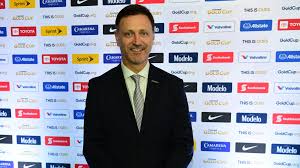By Paul Nicholson in Cleveland
June 24 – The Gold Cup in the US has now reached the end of the second round of games in what is a helter skelter schedule taking in 17 stadia in 15 cities – 13 in the US. Initially considered a risk with more teams and venues than ever before, the tournament has emphatically forced its way into the top tier of national team competitions in what is perhaps the busiest summer of global international competition ever.
The new 16-team Gold Cup format sees grouped teams play double headers every four days. For example, Group D which comprises the US, Panama, Trinidad and Guyana, concluded its second round of games Saturday in Cleveland. Last Wednesday the teams had been in St Paul, Minnesota, and on Wednesday they play in Kansas City. It is a triumph of organisation and co-ordination.
Philippe Moggio, general secretary of Concacaf, was understandably upbeat about a tournament that has seen an avalanche of goals and is involving more member associations than ever before.
“We are very pleased and excited about how the tournament is going. From an audience and an attendance perspective we are performing at a good level. We had 65,000 at our opening match in the Rose Bowl in Pasadena, we had 52,000 in Denver, we sold out in Minnesota. We are trending at over 30,000 for each game. A lot of this is due to the work we have put in over the past year,” he said.
At the core of the marketing has been the ‘This is Ours’ tournament tagline that Moggio says “speaks to our fan base. It is resonating with fans. We are also working hard with our media partners and that is showing in their numbers and on our own fan engagement platforms.”
The decision to expand the Gold Cup to 16 teams from 12, was not universally popular with critics saying the additional four teams would lower the quality of the tournament. The reality is that hasn’t been the case, in fact probably the opposite.
“We took a big risk going from 12 to 16 and people questioned that. We take a long term view. We can’t just rely on out top two nations (Mexico and the US) and stay at that. We need a more balanced and more competitive membership and that will raise the standard across the confederation. We are seeing it already,” said Moggio.
The clearest example being the giantkilling of Curacao, who had never before won a Gold Cup game but overcame World Cup 2010 and 2014 finalists Honduras. “Curacao is an example of the competitive change, beating a perennial contender. Look at Bermuda and how they played. We also have Haiti against Costa Rica which I think will be close,” he continued.
“It comes out of (the extra competition provided by) a fantastic Nations League this year. It demonstrates a more competitive balance. This is now a different competition for all our teams and we are seeing great results.”
This edition is the first time the Gold Cup has been played outside of North America with Costa Rica and Jamaica hosting games. Moggio smiles when talking about the experiences of going outside the comfort zone of US stadiums and US-based crowds. “We were a bit worried, especially in Jamaica when we saw ticket sales with a day to go. The local organisers weren’t at all worried. The kept saying ‘it is OK, don’t worry’ and they (the fans) all showed up. It was a fantastic atmosphere of positive energy. It was also a significant commitment to growth from our federations.”
Moggio does recognise the pressure the number of venues puts on the organisation. “We are in 15 markets in the US with the Gold Cup. It is a lot for a small team and it is important to recognise this.”
Will the experience of going to new countries be continued? “First we must finish this Gold Cup and see how we did overall and put everything into perspective. But one we will do is continue our evolution.”
Contact the writer of this story at moc.l1714121112labto1714121112ofdlr1714121112owedi1714121112sni@n1714121112osloh1714121112cin.l1714121112uap1714121112

